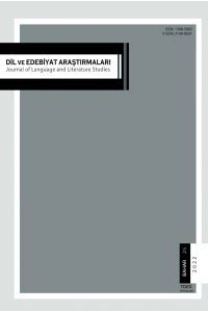Old Age and Greed in Ṣāʾib Tabrīzī’s Ghazals
Old Age and Greed in Ṣāʾib Tabrīzī’s Ghazals
Saeb Tabrizi, Indian Style, Sabk-e Hindi, Persian poetry, metaphors, im- agery, old age greed.,
___
- Al-Bukhārī, M. I. (1997). The Translation of the Meanings of Sahîh Al- Bukhâri (Vol. 8) (M. M. Khan, Trans.). Riyadh: Darussalam.
- Al-G̲h̲azālī, A. (1356). Iḥyāʾ Ulūm al-Dīn. Cairo: Nashr al-Thaḳāfat.
- Anvarī (1340). Dīvān-i Anvarī, (M. T. M. Raḍavī Ed., Vol. 2: Muqaṭṭaʿāt-Ghazaliyyât-Rubāʿiyyāt). Bungāh-i Tarjuma va Nashr-i Ketāb.
- Aṭṭār (1388). Elāhīnāma (M. R. Sh. Kadkanī, Ed., 5nd Ed.). Tehran: Intishārāt-i Soḥan.
- Bausani, A. (1958). Contributo a una Definizione dello Stile Indiano della Poesia Persiana. Annali dell'Istituto Universitario Orientale di Napoli Nuova Serie, 7, 167-178.
- De Brujin, J.T.P. (1995). SABK-I HINDĪ. In C. E. Bosworth et al. (Eds.), The Encyclopedia of Islam New Edition (Vol. VIII, pp. 683-685). Leiden: Brill.
- Dehlavī, A. Kh. (1361). Dīvān-i Kāmil-i Amīr Khusraw Dehlavī (S. Nafīsī, Ed., 2nd Ed.). Tehran: Sāzmān-i Intis̲h̲ārāt-i Jāvīdān.
- Ganjavī N. (1335). Kulliyyāt-i Dīvān-i Ḥakīm Niẓāmī Ganjavī (V. Dastgardī, Ed.). Tehran: Amīr Kabīr.
- Jāmī, N. ʿA. (1378). Dīvān-i Jāmī (A. Afṣaḥzād, Ed., Vol. 2: Vāsiṭat al-ʿAqd, Khātimat al-Ḥayāt). Tehran: Markaz-i Muṭālaʿāt-i Īrānī.
- Kāshānī, K. M. (1380). Haft Dīvān-i Muḥtasham Kāshānī (A. Navāyī & M. Ṣadrî, Eds., Vol. 2), Mīrāth-i Maktūb.
- Losensky P.E. (2003). ṢĀʾEB TABRIZI. In Encyclopædia Iranica online edition, retrieved on 6 July 2020 from iranicaonline.org/articles/saeb-tabrizi .
- Masʿūd Saʿd, (1364). Dīvān-i Masʿūd Saʿd (M. Nūriyān, Ed., Vol. 1). Iṣfahān: Ketābfurūshī-i Kemāl.
- Mevlânâ Celâleddîn Muhammed. (2007). Mesnevî-i Ma̒nevî (A. Karaismailoğlu & D. Örs, Eds., Vol. 1-2). Ankara: Akçağ.
- Muʿizzī, (1318). Dīvān-i Amīr al-Shuʿarā Muḥammad b. Abd al-Malek Nīshābūrī Mutakhallaṣ ba Muʿizzī (A. Eqbāl, Ed.). Tehran: Ketābfurūshī-i Islāmiyya.
- Nafīsī, S. (1341). Muḥīṭ-i Zindegī va Aḥvāl va Ashʿār-i Rūdakī. Tehran: Intishārāt-i Ketābkhāna-i Ibn Sīnā.
- Naẓīrī, M. Ḥ. (1379). Dīvān-i Naẓīrī Nīshābūrī, (M. R. Ṭāhirī, Ed.). Tehran: Negāh.
- Rahman M. (1995). ṢĀʾIB. In C. E. Bosworth et al. (Eds.), The Encyclopedia of Islam New Edition (Vol. VIII, pp. 851-852). Leiden: Brill.
- Saʿdī M. A. (1385). Kulliyyāt-i Saʿdī (M. A. Furūghī, Ed.). Tehran: Intis̲h̲ārāt-i Hermes.
- Ṣafā D̲h. (1392). Tārīk̲h̲-i Adabiyyāt Dar Īrān (12nd Ed., Vol. 5/2). Tehran: Intishārāt-i Firdaws.
- Ṣāʾib, M. A. (1381). Ghazaliyyāt va Abyāt-i Barguzīda-i Mavlānā Ṣāʾib Tabrīzī (M. Ḳahramān, Ed.). Isfahan: Intishārāt-i Shāhnāma Pezhūhī.
- Sāvajī S. (1348). Jamshīd ū Khūrshīd (J. P. Asmussen & F. Vahman, Eds.). Tehran: Bungāh-i Tarjuma va Nashr-i Ketāb.
- Sīstānī F. (1335). Dīvān-i Ḥakīm Farrukhī Sīstānī (M. Dabīrseyāqī, Ed.). Tehran: Eqbāl.
- Tabrīzī, M. A. Ṣ (1364). Dīvān-i Ṣāʾib Tabrīzī (M. Ḳahramān, Ed., Vol. 1). Tehran: Sherkat-i Intishārāt-i Elmī va Farhangī.
- Tabrīzī, M. A. Ṣ (1365). Dīvān-i Ṣāʾib Tabrīzī (M. Ḳahramān, Ed., Vol. 2). Tehran: Sherkat-i Intishārāt-i Elmī va Farhangī.
- Tabrīzī, M. A. Ṣ (1366). Dīvān-i Ṣāʾib Tabrīzī (M. Ḳahramān, Ed., Vol. 3). Tehran: Sherkat-i Intishārāt-i Elmī va Farhangī.
- Tabrīzī, M. A. Ṣ (1367). Dīvān-i Ṣāʾib Tabrīzī (M. Ḳahramān, Ed., Vol. 4). Tehran: Sherkat-i Intishārāt-i Elmī va Farhangī.
- Tabrīzī, M. A. Ṣ (1368). Dīvān-i Ṣāʾib Tabrīzī (M. Ḳahramān, Ed., Vol. 5). Tehran: Sherkat-i Intishārāt-i Elmī va Farhangī.
- Tabrīzī, M. A. Ṣ (1370). Dīvān-i Ṣāʾib Tabrīzī (M. Ḳahramān, Ed., Vol. 6). Tehran: Sherkat-i Intishārāt-i Elmī va Farhangī.
- The Holy Qur’ān and Its Meaning (2018). (A. Y. Ali Trans.). Ankara: Publications of the Presidency of Religious Affairs.
- Yakut, E. (2020). Hint Üslubu Şairlerinin Yeni Mazmun İcadında Gelenekten İstifadesi. In M. Yılmaz & A. Aksu (Eds.), Cemal Aksu Armağanı. (pp. 347-385). İstanbul: İstanbul Üniversitesi Yayınları.
- Yarshater, E. (1974). Safavid Literature: Progress or Decline. Iranian Studies, 7 (1/2), 217-270.
- Yarshater, E. (2006). Persian Poetry in the Timurid and Safavid Periods. In P. Jackson & L. Lockhart (Eds.), The Cambridge History of Iran (Vol. 6: The Timurid and Safavid Periods) (pp. 965-994). Cambridge: Cambridge University Press.
- ISSN: 1308-5069
- Yayın Aralığı: 2
- Başlangıç: 2010
- Yayıncı: TÜRKİYE DİL VE EDEBİYAT DERNEĞİ
Old Age and Greed in Ṣāʾib Tabrīzī’s Ghazals
16. Yüzyıla Ait Satır Altı Farsça-Türkçe Sözlük
Mustafa GÜNEŞ, Mümin HAKKIOĞLU
Janus’un Yüzü Ve Türk Edebiyatında Kanon, Karşı-Kanon Meselesi
Osmanlı Mizahında Kayzer Wilhelm İmajı
A Phenomenological Approach towards Early Literacy Development Practices of Early Childhood Teachers
